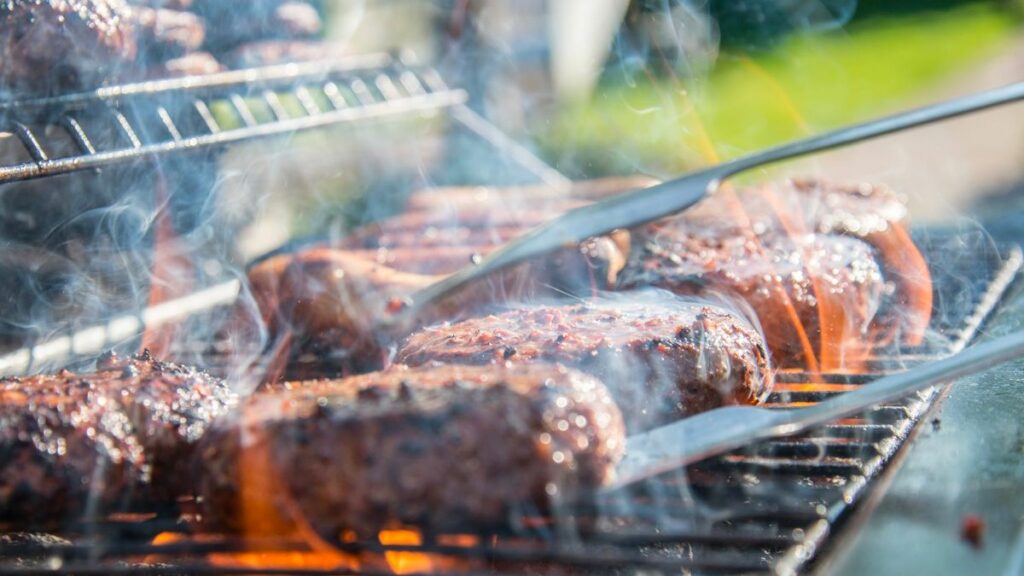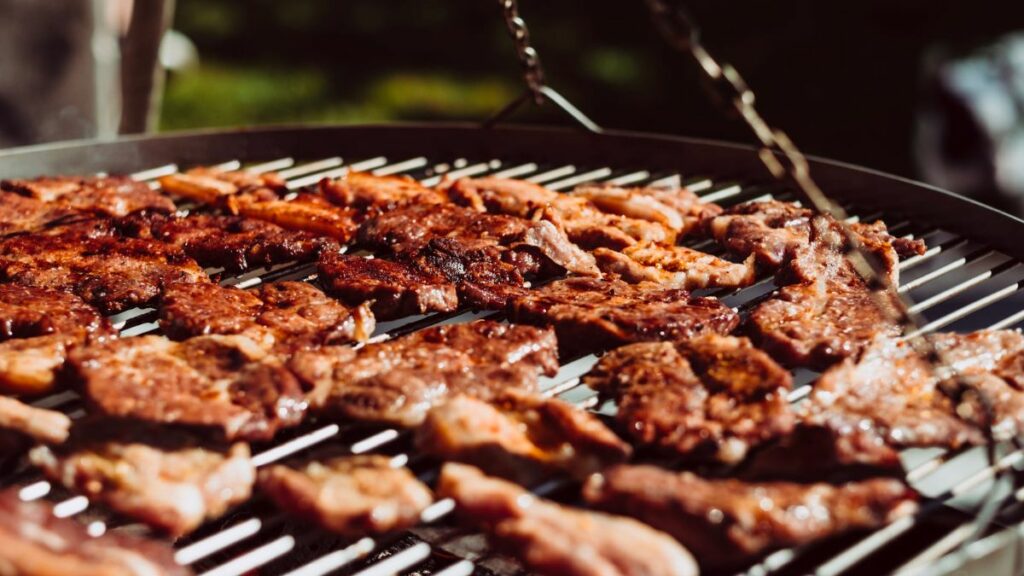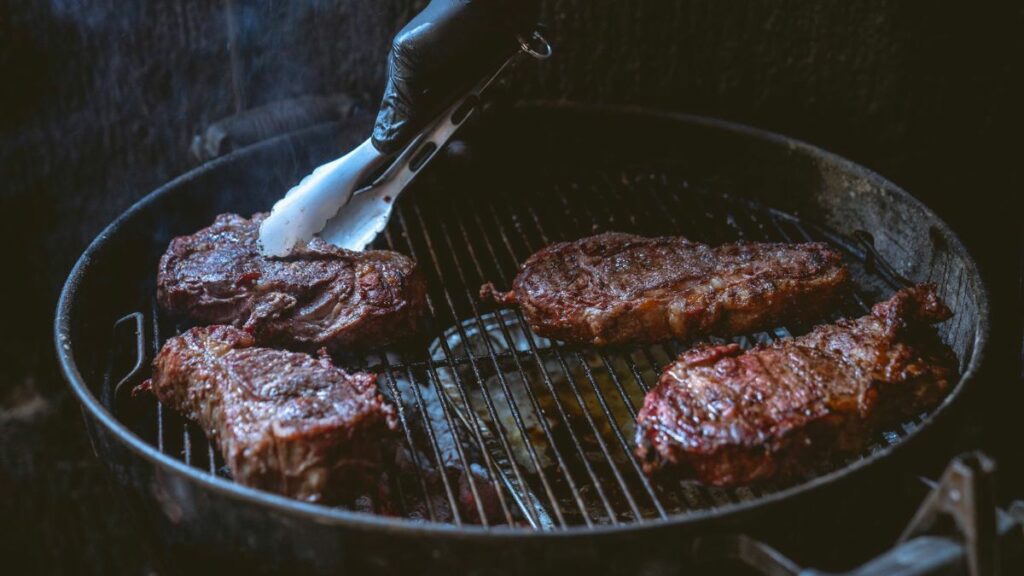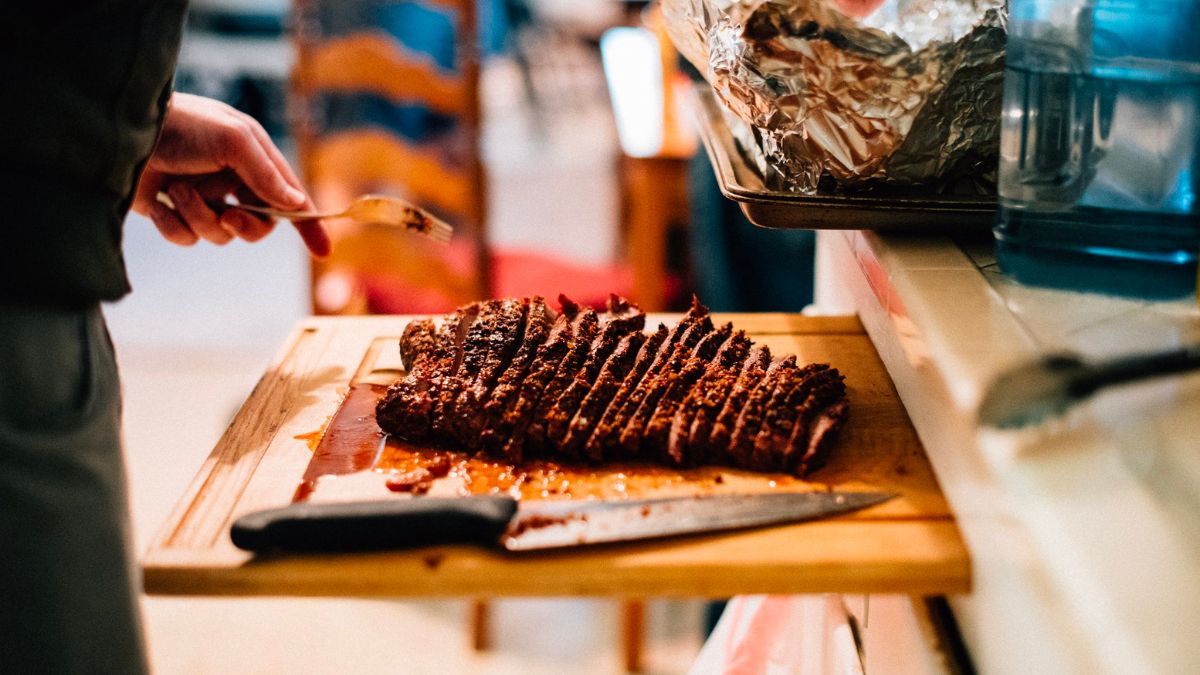The Importance of Brisket Internal Temperature. Brisket is one of the most popular cuts of meat for barbecue. A well-cooked brisket is crispy on the outside and juicy in the center.
The best way to cook a perfectly tender brisket is by smoking it at low and slow temperatures. The internal temperature range for a perfect brisket is between 190 and 205 degrees Fahrenheit.
Smoking
Brisket is a challenging cut that requires a long and slow cooking method to break down all the connective tissues. This will allow you to get a juicy and flavorful smoked brisket that everyone will love.
Ideally, the internal temp of a brisket should be between 190 and 204 F (95-98oC) to achieve that perfect smokiness and tenderness. However, this number can vary depending on several factors including the size of the brisket, your smoker’s airflow, your fuel source, and how you injected the meat with spices.

It’s also important to realize that a brisket needs to rest for a couple of hours after smoking in order to let it relax and reabsorb some of the juices that were squeezed out during cooking. If you cut your brisket immediately after smoking, some of these juices will be lost and dry up quickly.
Smoking a brisket can take anywhere from 10 to 20 hours, depending on the size of the brisket. A brisket can weigh 16 pounds or more, so it’s crucial to give yourself plenty of time for the cooking process.
One of the best ways to keep track of your brisket’s internal temperature is with a meat thermometer. These are not expensive and are easily found in most grocery stores and online.
Thermometers can be used to monitor the brisket’s internal temperature throughout the cooking process. Once your brisket reaches an internal temperature of 155-165F, you’ll want to remove it from the smoker and wrap it in butcher paper or foil. This will prevent evaporative cooling, which can cause soft mushy bark on the surface of your brisket.
Once you have the brisket wrapped and set back in your smoker, reset the high temp probe on your Smoke. It will automatically sound a high alarm when the meat hits 150degF, and you can then start the process of wrapping again.
This is a critical step because it can make or break your finished brisket. If you skip this step, the meat will end up dry and tough, making it a no-no for most people. But if you wrap it correctly and allow it to rest properly, the result is going to be a beautifully smoked brisket that’s tender and delicious!
Temperature
Unlike most meats, a brisket needs a long cooking time to render the fat and tenderize it. It also has to reach a certain internal temperature, which is crucial for flavor and texture.
The best internal temp for a brisket is around 195 degrees Fahrenheit in the flat area and 210 degrees in the point. This temperature range is where the connective tissue, which is made of collagen, breaks down into gelatin and gives the meat a rich and delicious texture.
Most pitmasters recommend using a probe to check the brisket’s internal temperature. This means inserting the probe into the flat and point parts of the brisket. When the brisket reaches the proper temperature, the probe should slide in and out with little resistance.
If you don’t have a probe, there are other methods for checking the meat’s internal temperature. You can jiggle it with your hand or use the tug test. However, these methods will release the heat and disturb the cooking process.

Once you have smoked your brisket to the desired internal temp, it’s time to wrap it. This will give the brisket the ultimate tender texture and a beautiful, dark bark.
To wrap the brisket, you need to cut it into half-inch thick slices and place it on butcher paper or aluminum foil. Then, put it back in the smoker at the same temperature. After the brisket has been wrapped for about an hour, you need to let it rest.
During this resting time, the brisket’s temperature will equalize and some of the juices that were squeezed out during smoking will be reabsorbed by the meat. This will also ensure a juicy and tender piece of meat when you pull it off the grill.
A brisket can take hours to reach its optimal internal temp, so you should always keep an eye on it to make sure it doesn’t overcook or become tough and dry. Thankfully, there are a few steps that you can follow to ensure that the brisket stays at the perfect internal temp and avoid the common problem of hitting “the stall.”
To prevent the stall, the best way is to wrap your brisket as soon as the exterior bark begins to darken. You can use butcher paper or aluminum foil to wrap it, and after the brisket has been wrapped, you need to return it to the smoker and continue smoking until it reaches the 205 degree mark.
Time
The brisket internal temp is one of the most important factors in smoking a delicious, moist and tender brisket. There are many factors that affect this temperature, but the most important factor is keeping a close eye on it at various stages of the cooking process.
Ideally, the brisket internal temp should be between 195degF and 204degF. This allows the collagen and connective tissue to breakdown into gelatin which gives the meat its juicy and tender texture and smoky flavor.
However, this is a variable and depends on many different factors such as the size of your brisket, the type of smoker you are using, the airflow and water pan usage, the moisture content, and the accuracy of your thermometer. It is possible to end up with a brisket that is undercooked or overcooked depending on these factors.
Another key factor is time. The longer a brisket is in the smoker, the more it will absorb heat from the smoke and begin to cook. This process is known as carryover and it can take several hours before your brisket reaches its desired internal temp.
If your brisket isn’t cooked to a high enough internal temp, it will dry out and become tough. When this happens, it will fall apart easily. The best way to avoid this is to follow the recipe exactly and keep an eye on your brisket’s internal temperature at all times.
Once your brisket has reached its desired internal temp, you can remove it from the smoker. This is a crucial step and will ensure that the meat remains tender and full of juices as you carve it.
After you have removed your brisket, wrap it tightly in either food-grade pink butcher paper or aluminum foil. This will help prevent evaporation from stalling the cooking process.
Finally, let the brisket rest for at least an hour to redistribute the juices and to allow the meat to cool down. This will make the brisket much easier to carve and will result in more even cuts of meat.
The brisket can be pulled off the smoker when it reaches an internal temperature of at least 190degF. You can use your Smoke’s Pro Series high temp cooking probe* to measure this temperature on both the flat and point of your brisket.
Control
One of the most important things to control when smoking is the internal temperature. Maintaining an even and consistent temperature is key to producing a tender, juicy brisket.
When a brisket is smoked, it goes through a slow and controlled cooking process that requires patience and attention to detail. It’s also important to keep track of the brisket’s internal temp using a thermometer so that you know when it’s ready for a resting period and slicing.
A smoker can be a frustrating tool to use when it comes to maintaining the brisket’s internal temp, but there are a few tricks you can try to get your brisket cooking consistently. First, avoid opening the lid as much as possible to help keep the brisket at the correct internal temperature.
The second thing you can do is use a probe thermometer to monitor the brisket’s temperature throughout the cook. Most smokers come with probes that allow you to check on the brisket without opening the smoker.
If you have a digital probe thermometer, you can place it in the thickest part of the brisket and monitor the temperature. If you don’t have a digital thermometer, you can use a meat fork or other utensil to test the meat’s temperature.
Many pitmasters believe that the best internal temperature for a brisket is 190 degrees. This is where the muscle fibers and connective tissue denature and break down, transforming the tough piece of meat into a tender, flavorful cut.
Another way to increase the brisket’s tenderness is to add a sauce or other liquid during the cooking process. This will help keep the brisket moist during the cooking process, and it’ll prevent the meat from drying out too quickly.
Finally, if you have the time, wrapping your brisket during the final cooking phase is an excellent way to lock in the juices. However, wrapping brisket can take a long time, so it’s best to wrap brisket after the smoker has reached a high internal temperature and you have a rich, dark bark.
Regardless of which technique you choose to use, keeping the brisket at a consistent temperature is the best way to ensure that it’s cooked evenly and properly. The heat and wood smoke will slowly penetrate the brisket’s interior, turning it into a flavorful meal that you and your guests will love.
Smoked Brisket Recipe
Getting a tender, moist, and flavorful smoked brisket isn’t easy, but it can be done! Start by picking up a USDA Choice grade brisket that has a moderate amount of marbling.
Trim off any excess fat from the brisket before smoking to minimize the chances of drying it out. Then, season the brisket thoroughly with Kosher Salt and Black Pepper. You can optionally add Garlic Powder as well.

Seasoning
Smoking brisket is an excellent way to add a touch of smoky flavor to your meal. The key to success is making sure the meat is well seasoned. There are many different ways to season a brisket, from marinating it before smoking to using a rub. Regardless of the method, a well-seasoned brisket will be incredibly tender and delicious.
The best way to season a brisket is with a dry rub. This is an easy, inexpensive way to add tons of flavor to your brisket.
A good dry rub starts with coarse salt and pepper. It should also include a good amount of smoked paprika, chili powder, and a hearty pinch of cayenne pepper for heat. In addition, you can add garlic powder, cumin, and dry mustard to the mix.
You may even want to add a small amount of brown sugar to the mix, but only if you prefer a sweeter brisket. Otherwise, you’ll be left with a bitter final product.
If you like a spicy kick, you can also add some hot sauce to the mixture. Just be sure to check the label before purchasing it, as some hot sauces can have high levels of sulfites.
Once you have your dry rub, use your hands to apply it liberally to the surface of your brisket. This is important for getting an even distribution of the seasonings all over the brisket, and it’s important to allow the brisket to rest with the dry rub on at room temperature for an hour before cooking.
When smoking your brisket, it is important to make sure the smoker is working correctly. To do this, you need to know how to set the temperature and keep the smoker at the right level throughout the cooking process. It also helps to smoke with a water drip pan so that the brisket doesn’t dry out or catch fire.
When you’re ready to cook your brisket, place it in the smoker and turn on the flame. Then, let the brisket cook for 4 to 5 hours until it’s tender and cooked through. It’s important to remove it from the smoker when it reaches an internal temperature of 185 degrees F.
Wrapping
Wrapping your brisket before placing it on the smoker will ensure that it cooks more evenly and retains its moisture throughout the entire process. In addition, it will ensure that the internal temperature stays at a higher level, which means that your brisket will be juicier and more tender than it would have been if left unwrapped.
The most common method for wrapping a brisket is using aluminum foil. This is the most sanitary way to wrap the meat, and it can help it reach a higher internal temperature faster.
Another option for wrapping your brisket is butcher paper. This type of paper is more porous than aluminum foil, which allows smoke to reach the meat and create a flavorful bark. However, it is not as effective at retaining moisture as foil, which could result in the brisket drying out more quickly than it would if wrapped with foil.
Finally, some people choose to use Parchment paper as a substitute for butcher paper. This type of paper is made from deoxidized elements, which makes it healthier and more environmentally friendly than other types of paper.
When it comes to the final stage of smoking a brisket, most recipes suggest wrapping your brisket before you place it on the smoker. This step is crucial because it allows you to prevent the infamous brisket stall, which happens when the brisket’s internal temperature goes down to 150 degrees Fahrenheit or lower for long periods of time.
This happens because the brisket is sweating off liquids, which cools it down and slows down the cooking process. As a result, the brisket may not reach a high enough internal temperature to fully render the intramuscular fat out of it.
To avoid this, many people wrap their brisket before they place it on the smoker. While this can make the cooking time slightly longer than if the brisket were cooked all the way through, it will help to keep the meat from drying out too much and will allow you to get your brisket at the ideal internal temperature for serving.
Serving
Smoked brisket is a delicious recipe that is often served with a variety of side dishes. Whether you are hosting a family dinner or throwing a party, these easy side dishes can make any meal more memorable.
One of the most popular side dishes to go with smoked brisket is corn on the cob. The sweet flavor of the cob pairs well with the smoky meat to create a heavenly treat. It is also a healthy side dish that is easy to prepare.
Another great option for a smoked brisket side dish is steamed asparagus. This vegetable is filled with many vitamins and minerals and can be cooked in different ways. Steaming it with lemon juice and salt will improve its flavor.
This vegetable is a good source of protein and fiber, which can help you stay in shape. It is also a healthy alternative to potatoes.
The best way to serve asparagus is to lightly steam it and add a little lemon juice or salt and pepper. This will increase its flavor and texture.
Regardless of what you decide to serve with your smoked brisket, the main goal is to make sure that everyone has a tasty and satisfying meal. The right side dish can make your smoked brisket the star of the meal!
In addition to corn on the cob, there are plenty of other savory side dishes that pair well with smoked brisket. From creamy coleslaw to baked beans and corn pudding, these easy side dishes can turn your brisket into a delicious feast!
While preparing your brisket, be sure to keep in mind the importance of resting the meat. The longer it rests, the better it will soak up the flavors of the smoke. If you do not rest your brisket properly, the meat will become dry and tough.










